smell
1/27
There's no tags or description
Looks like no tags are added yet.
Name | Mastery | Learn | Test | Matching | Spaced |
|---|
No study sessions yet.
28 Terms
what is the purpose of smell?
predators
prey
food
navigation
danger
communication
reproduction
what is an odour?
the perception of smell
what is an odorant?
a molecule that has an odour
what is the difference between generalisability and discrimination in the olfactory system?
olfactory system can generalise odours (e.g the smell of an apple)
other times the olfactory system can discriminate between different odours (e.g granny smith vs pink lady apple)
where are olfactory receptor neurons located?
olfactory epithelium in the nasal roof of the nasal cavity
this covers parts of the cribiform plate of the ethmoid bone, upper part of the nasal septum and the superior nasal concha
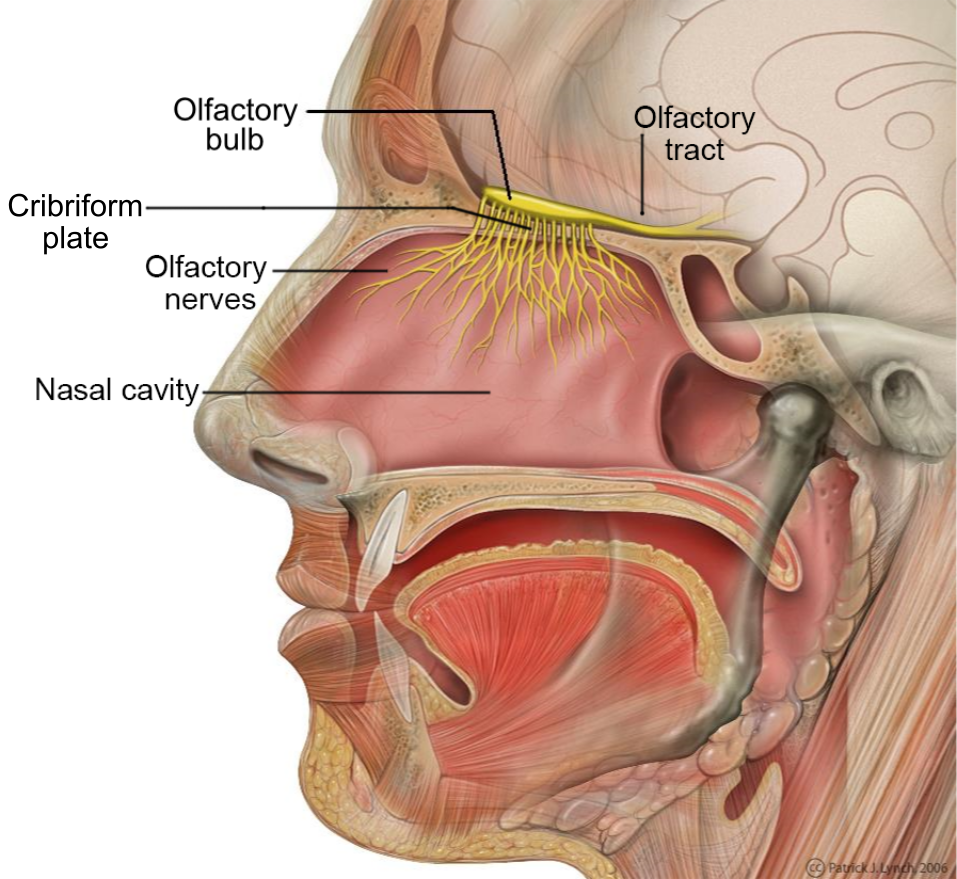
what is the structure of the olfactory epithelium?
olfactory sensory/receptor neurons detect odour molecules, bipolar dendrites ending in olfactory cilia that project into mucus layer, axons bundle to form CNI that passes through the cribiformplate to the olfactory bulb
supporting cells provide metabolic and physical support to the olfactory neurons, help detoxify harmful substances
basal stem cells can diffrentiate into new olfactory sensory receptors to regenerate (olfactory neurons only have a lifespan of ~30-60 days)
cilia are hair like projections from dendrites of OSNs where odorant receptors are located
mucus layer is secreted by bowmans’s glands which trap odour molecules and dissolve them so they can bind to receptors
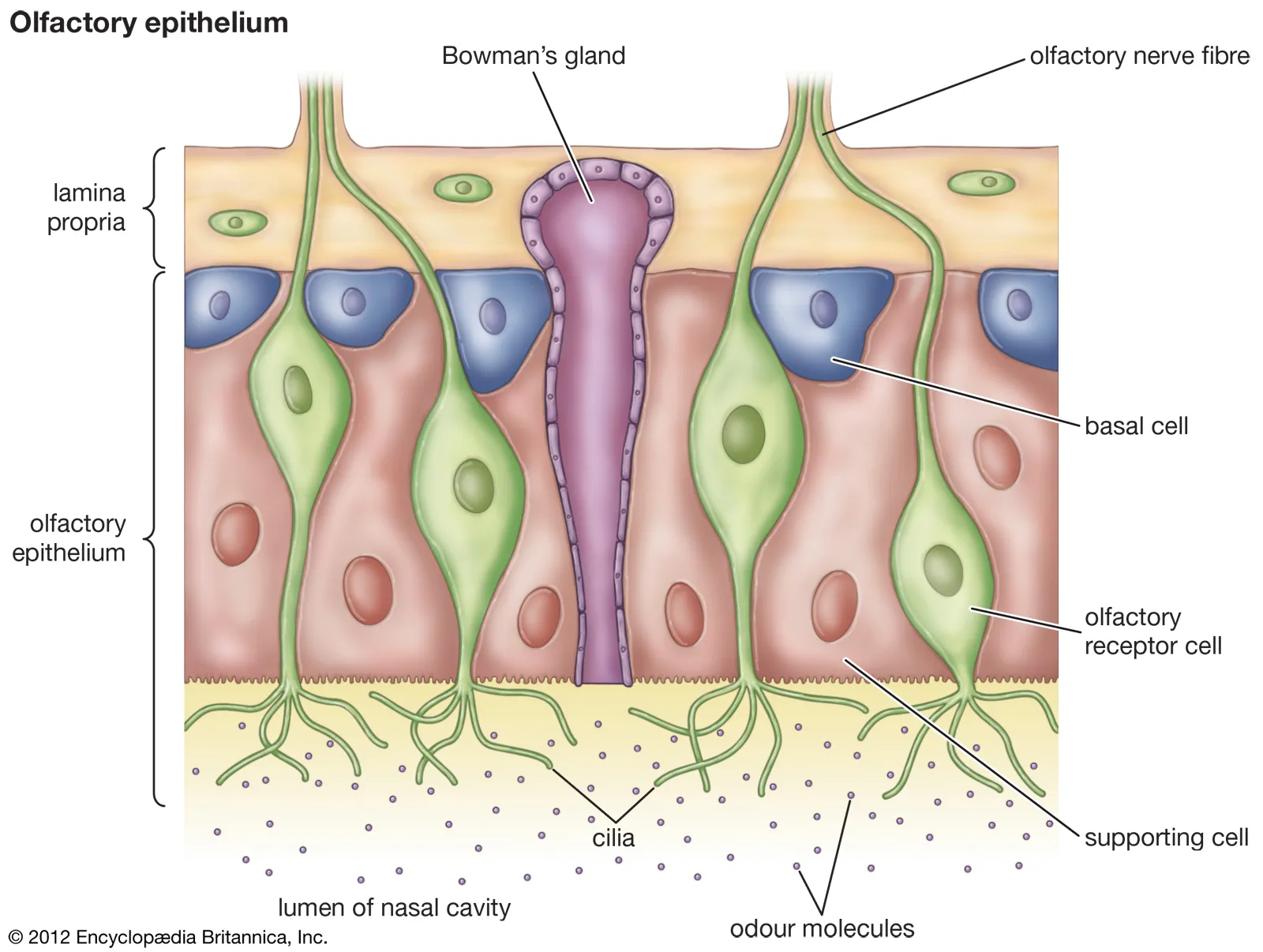
how can the olfactory pathway be explained as a path?
odour molecules enter the nasal cavity and dissolve in the mucus secreted by bowmans glands
molecules bind to olfactory receptors on the cilia of OSNs
binding activates the neurons, generating a nerve signal
signal travels along olfactory nerve fibres through the cribiform plate
fibres reach the olfactory bulb where the signal is processed and relayed to the brain
is olfactory neuron depolarisation graded or all-or-nothing?
graded
the more odorant molecules that bind, the more channels that open and this created a larger inward current
this varies with stimulus intensity therefore frequency of action potentials reflects the strength of the odour stimulus
TF receptor potential is graded at the cilia level
how does olfactory depolarisation occur?
odour molecule binds to a specific olfcatory G-protein coupled receptor on the cilia
receptor activates a G-protein called golf
golf exhanges GDP for GTP on its alpha subnit (activation)
activated golf stimulates adenylate/adenylyl cyclase III
this converts ATP into cAMP
cAMP binds to cyclic nucleotide-gated channels in the ciliary membrane and this allows sodium and calcium influx (non-specific cation)
calcium also activates chlroide channels
influx of sodium and calcium + chloride efflux = membrane potential becomes positive = graded receptor potential
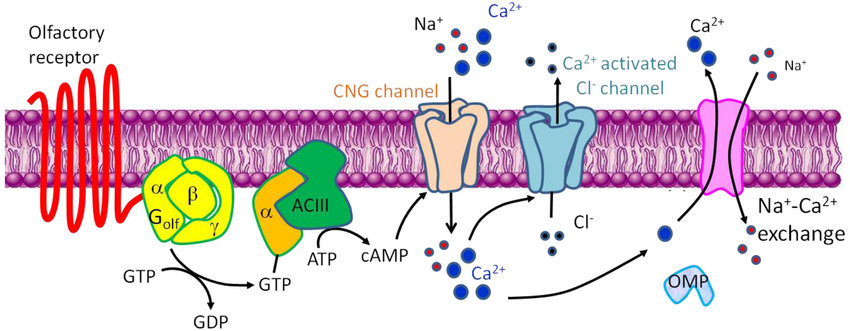
is there diversity in olfactory receptors?
ORs are part of 7TM G-protein coupled receptor family
genomi studies show that the OR gene family is large and highly diverse- mammals have 100-1000 OR genes
each OR gene encodes a receptor that can bind different odour molecules
transmembrane regions contain amino acids (variable residues) that form the binding pocket for odour molecules
this means humans and animals can detect a huge variety of odours and each OR has a unique odour-binding specificity
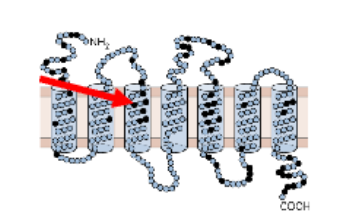
how do OR genes differ in macrosmatic animals and humans?
macrosmatic animals e.g mice have over 1000 functional OR genes which allows them to detect and discriminate a vast range of odours which are crucial for finding food and detecting predators
humans have only around 400 functional OR genes, the rest have become pseduogenes
this is why humans generally have a less acute sense of smell
do ORs respond to multiple odorants?
OSNs are one receptor per neuron meaning each OSN produces only one type of olfactory receptor
however each OR can bind to several structurally related odour molecules so a single OSN can be activated by several odorants
if you record from a single OSN, you cannot tell exactly which odorant is present because the neuron could fire for any of the odorants that its OR recognises = the signal is ambigious at the level of one neuron
to resolve this the brain uses combinatorial coding
how does combinatorial coding work in olfaction?
different odorants activate different sets of OSNs
olfactory bulb and higher brain centres read the pattern of activity across many OSNs
this pattern recognition allows the brain to identify the specific odour, despite individual neurons being ambigious
what is the structure of the olfactory bulb?
OSNs send their axons into the olfactory bulb and these axons converge on structures called golmeruli (relay sttaions where OSNs synapse)
primary dendrites of mitral and tufted cells receive input from the OSNs at the glomeruli
these are the main projection neurons of the olfactory bulb
periglomerular and granule cells (inhibitory interneurons) modulate the activity of mitral and tufted cells
inhibition sharpens the contrast between different odour signals (lateral inhibition), filters backgroud noise and enhances odour discrimination
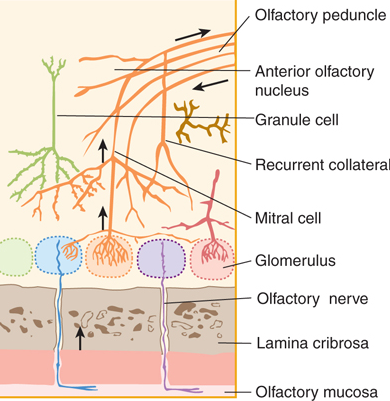
what is the function of mitral cells?
projection neuron in main olfactory bulb
deeper in the bulb
larger than tufted cells
long range, strong signals
main relay to cortex
what is the function of tufted cells?
projection neuron in main olfactory bulb
closer to glomeruli
small and short range
complememt mitral cells
what are glomeruli?
spherical structures within the olfactory bulb
act as relay stations where OSNs synapse onto mitral and tufted cells
inhibitory interneurons interact here to modulate the signal
each glomeurlus receives axons from only one OSN that express the same type of olfactory receptor
this convergence ensures that signals from the same receptor type are pooled together
this means the glomerulus is a basic processing unit for odour information
what are glomerular patterns?
each odour activates a specific set of glomeruli in the main olfactory bulb and this forms a spatial activity map = different odours produce different glomerula patterns
scientists can use imaging techniques to observe olfactory input and mitral cell response
what are granule cells?
inhibitory interneurons that do not have axons (only dendrites)
form reciprocal dendrodritic synapses with mitral cells
mitral cell dendrites excite granule cell dendrites whereas granule cell dendrites inhibit mitral cell dendrites
this provides lateral inhibition which sharpens mitral cell response and enahnces contrats between different odours
what are periglomerular cells?
inhbititory interneurons
regulate OSN input to mitral cells
form reciprocal dendrodendritic syanpses with mitral cell dendrites providing local inhibition
thereofre regulate input at the glomeruli
what is the main olfactory pathway?
MOB receives signals from OSNs at golmeruli, signals relayed by mitral and tufted cells
anterior olfactory nucleus sends signals from olfactory bulb to both ipsilateral and olfcatory bulbs via anterior commissure
piriform cortex receives direct input from the MOB
perihinal/entorhinal cortex

what can the MOB directly project to?
cortical and medical nuclei of the amygdala which mediates the emotional and instictive responses to odours (e.g fear and attraction)
where can the piriform cortex project to?
orbitofrontal cortex via the thalamus (medial dorsal nucleus) or directly
OFC = odour disrcimination, identification and conscious perception of smell
where can the entorhinal cortex project to?
hippocampus
links odours to memory and contextual info
important for odour recognition memory and associative learning
what are the functions of the central brain regions in the olfactory pathway?
main olfactory bulb = odorant features, important for refinement and contrast enhancement
piriform cortex (primary olfactory cortex) = higher-order odour processing and perception to recognise complex spells
perihinal cortex = links odors to objects and experiences (odor-object association)
entorhinal cortex = interfaces with hippocampus for odour-related memory and spatial/contextual associations

divergence and convergence in the MOB and piriform cortex
~1800 glomeruli in MOB
1: ~100,00 divergence = one mitral/tufted cell can send acons to multiple locations in piriform (spread odour information widely)
~200:1 convergence = one cortical neuron in pirifom can receive input from many mitral/tufted cells (intergrate signals from multiple glomeruli)
more diveregence to enable combinatorial coding and spread of info
excessive convergence would blur distinctions between odours
how do piriform neurons respond to specific patterns of glomerular input?
each piriform cortex neuron receives input from multiple mitral/tufted cells which correspond to different flomeruli
the neuron does not respond to a single glomerulus, it responds to a specific combination or pattern of active glomeruli
this allows combinatorial coding and suppoers odour discrimination
what does the anterior piriform cortex (aPCx) represent?
located toward from of the olfactory cortex and receives direct input ffrom mitral and tufted cells in main olfactory bulb
the aPCx intergrates signals from multiple glomeruli to form a unified percept of an odour object
e.g a banana odour is composed of many chemical components (e.g isoamyl acetate and ethyl pentanoate) but the aPCx represents it as a single odour object
this is crcuial for recognition and categorisation of odours in real world contexts
